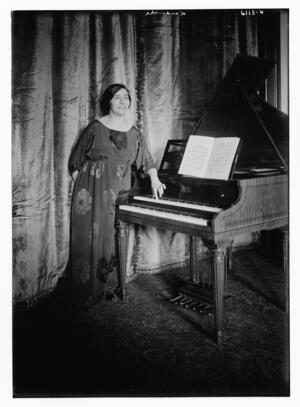Early music harpsichordist Wanda Landowska plays Bach at New York City's Town Hall
Born in Warsaw in 1879, Wanda Landowska studied piano at the Warsaw Conservatory, from which she graduated at age 14. In 1900, she moved to Paris, where she taught piano and performed. In both cities, she devoted herself to learning the harpsichord, an instrument which had all but disappeared from the active classical repertoire. Although Bach, Handel, and others had composed myriad harpsichord pieces, by 1900, virtually no one played the instrument and works written for it were generally transposed for piano. But Landowska was determined to play these works on the original instrument, despite discouragement from musicologists and fellow musicians.
In 1912, Landowska commissioned a harpsichord to be built for her own use; she later transported the instrument all over Europe for her numerous performances. She began to teach harpsichord in Paris and, after a stint in Berlin, opened her own school outside Paris in 1919. Already renowned as a teacher and performer, she made her U.S. debut in 1923, with the Philadelphia Orchestra. After her first New York recital the following year, she found a large following in the U.S. and played often to packed houses. In 1941, forced to flee Nazi-occupied Paris, Landowska and her life partner, Denise Restout, were eventually able to make their way to the United States where they settled permanently.
The following year, on February 21, 1942, Landowska made history with a performance of Bach's "Goldberg Variations" at New York's Town Hall. It was the first time in the 20th century that the piece, originally written for the harpsichord, was performed publicly on that instrument. It is now a staple of the repertoire. A Landowska student later remembered that hearing that first performance was "like being in front of one of the greatest wonders of nature." Landowska made a similar splash in 1948 with a performance of Bach's complete "Well-Tempered Clavier." Her mastery of the harpsichord inspired not only listeners and students, but also composers, several of whom wrote new harpsichord works especially for her.
In addition to playing and teaching, Landowska also wrote about music. A 1909 book, written with her husband (Henry Lew, who died in 1919), and first published in French, addressed "music of the past." During her years in the U.S., she published frequent essays and book reviews. After her death, some of this material, along with previously unpublished essays, was published as Landowska on Music (1964). In the volume's essays, Landowska wrote about the interpretation of Bach and other music. She also made a passionate case for the role of the individual performer as an interpreter. At a time when many musicians believed that a performer should simply reproduce the notes on the page as closely as possible, Landowska wrote that the performer should, instead, add her own style, combining intuition and knowledge to produce an "ecstasy of music."
Landowska was frequently honored for her work. She received citations from the Charles Cros Academy in France and from the U.S. National Federation of Music Clubs, both recognizing her recordings. France admitted her to the Legion of Honor in 1925, and awarded her the Grand Prix of the Paris Exposition in 1937. Landowska gave her last public performance in 1954. She died in Connecticut in 1959.
Sources:New York Times, August 17, 1959; August 23, 1959; December 20, 1964; June 19, 1983; July 10, 1999; www.glbtq.com/arts/landowska_w.html.




I came across a complete collection of Bach pieces for the harpsichord recorded by Landowska. I am now fascinated by her artistry and grateful to her for her passion and love for music. Thank you Madame Landowska!